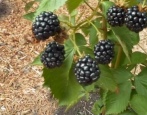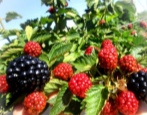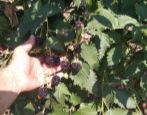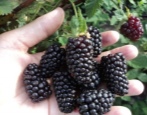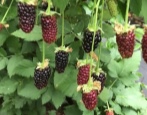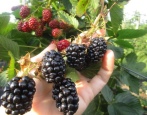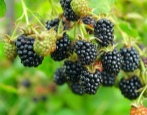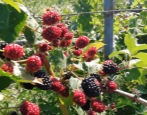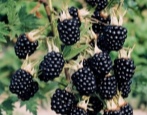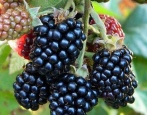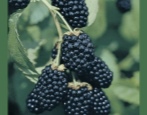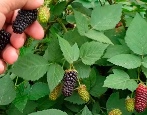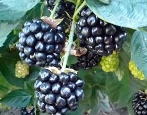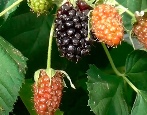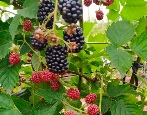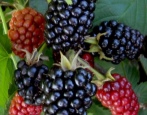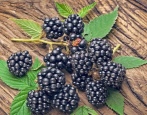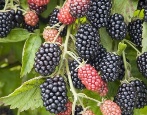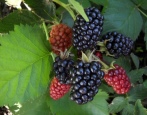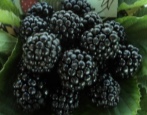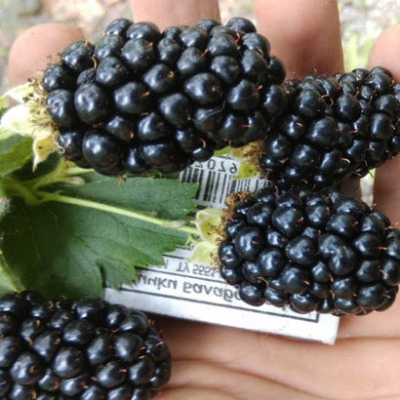
- Authors: Arkansas Institute, USA
- Taste: sweet
- Scent : thin, blackberry
- The presence of thorns: No
- Tasting assessment: 4,6
- Berry weight, g: 7-12
- Berry size: large
- Berry color: black
- Fruiting period: extended, June - July, 35-40 days, sometimes longer
- Yield: 15-20 kg per bush
The Natchez blackberry is deservedly popular among gardeners, because care and maintenance do not cause too much trouble. And sweet fruits, which ripen quite early, are pleasant and sweet.
Breeding history of the variety
Natchez is a fairly young variety. Its authors are the staff of the Arkansas Institute (USA). Breeder John Clark received a patent for this variety in 2007.
Description of the variety
The blackberry bush of this new variety is tall (average height is about 2 meters), spreading in shape. The shoots are long - 3-4 meters, over time from an erect position they turn into a more horizontal one. Branches are fragile, prone to breaking off. The plant has a powerful root system and is characterized by rapid growth, there are no thorns on it. The leaves are light green in color with a double surface, the edge of the leaves is dentate. The flowers are white and have 6 petals. Berries grow in clusters of 12-25 pieces.
Ripening terms
Natchez is ranked among the varieties of a fairly early ripening. For blackberries, the flowering period begins already in mid-May. Fruiting time is long and is approximately 40 days during June and July. With the organization of proper care and a comfortable temperature regime, fruiting can continue even more.
Growing regions
It is successfully grown in all regions of Russia. But in cold winters, additional shelter will be required.
Yield
Up to 20 kilograms of harvest can be removed from one blackberry bush during the season, therefore this variety is considered high-yielding.
Berries and their taste
Blackberry Natchez berries are deep dark blue, almost black, in color with a very pleasant sweet taste and delicate berry aroma. Sourness is sometimes felt. Specialists' tasting assessment 4.6 points. The pulp is juicy with a dense consistency. The shape of the berries is cylindrical, slightly elongated. The Natchez blackberry is quite large in size, while the berries of the first harvest have an average length of 3.5-4 centimeters, the average weight is 10 grams. In the future, the berries can reach the parameters of a matchbox, and the weight can be up to 20 grams. When the final ripening of the fruit occurs, the berries are easily torn off, because the sepal dries up.
Growing features
To successfully obtain a good harvest, the soil must be fertilized. When planting, it is necessary to observe the correct distance between individual bushes, which should be at least 3 meters. This variety prefers well-drained loamy soil. Acidification should be reduced, and groundwater should lie at a distance of at least one and a half meters from the surface. If the soil is too wet, it can cause root rot and even complete death of the plant.
Overgrown shoots under the weight of ripe fruits or due to strong gusts of wind can bend too much to the ground, therefore, support must be provided.
Site selection and soil preparation
For the active growth of blackberry bushes for planting, it is worth choosing well-lit areas. But it must be remembered that the plant does not like active sunlight too much, therefore, at a summer temperature of more than +35 degrees, the growing place should be shaded. Otherwise, the plant may get burned. And also the site must be protected from gusts of winds, which can lead to breaking off of blackberry shoots.
Pruning
After the end of fruiting, the shoots are cut at the root. Natchez has a low capacity for replacing blackberry shoots. Therefore, it is necessary to remove some new shoots in order to maintain a good level of fruiting. And also, with the help of a garden pruner, you should remove old shoots on which the berries will no longer form. To get a good harvest, only 5-7 fruiting shoots are enough for a plant of this variety. The side branches should be shortened by 30 centimeters.
Watering and feeding
Blackberries Natchez love moderate watering. Therefore, it is quite sufficient to water the plant once a week. In this case, it is necessary to use 4-5 buckets of water for one bush. When the ovaries form, watering should be more regular: once every 2-3 days, using 2 buckets of water. Do not allow the soil to dry out too much.
Top dressing of this blackberry variety is carried out 4 times during the year:
before wintering;
after the end of fruiting;
during the growing season;
before the onset of bud break.
Frost resistance and preparation for winter
The plant is characterized by insufficient frost resistance, therefore it is important to prevent the shoots from freezing. For this purpose, they need to be laid on the ground. Humus, corn leaves or sawdust can be used as insulation. In addition, it can be straw, vegetable tops or hay. Sometimes the leaves of fruit plants can be used, but this is best avoided, since they may contain harmful microorganisms.
Diseases and pests
The variety is distinguished by good resistance to many common diseases. Insects also rarely cause harm to bushes. However, you can further protect the blackberry bush. For this purpose, it is recommended to use:
1% bordeaux liquid;
peat or straw manure mulch;
tobacco dust solution.
Reproduction
Blackberries of Natchez variety propagate by rooting the apical shoots of the plant. The tops of young branches, which have reached about half a meter, must be cut off by 10-15 centimeters. Lateral new shoots will appear from the buds. After growing small leaves on the upper part, it is required to bend it to the soil and deepen it a little, by about 5 centimeters. After that, sprinkle the place of the deepening with a substrate. When the growing season is complete, the tops are already well rooted and buds of the growing season will appear.
In the next spring, it is necessary to make small cuts with a sharp razor, and the shoots are placed in small beds with moist soil. In the autumn, new shoots will appear on the incisions. When several shoots have formed, they should be dug up and disassembled into individual seedlings, while acting carefully so as not to damage the young root system in any way.
The preferred time to plant the Natchez blackberry is spring before bud break. This is due to insufficient resistance to low temperatures.
Review overview
In accordance with the reviews of gardeners, Natchez blackberries can be consumed immediately fresh. But it is also great for making sweet preparations and a variety of desserts.
Due to the good preservation during transportation, it is possible to transport berries over long distances, while the appearance is not lost. The presentation can be maintained for two weeks.
Natchez is a very good choice for cultivation in summer cottages or on specialized plantations for further commercial use.


